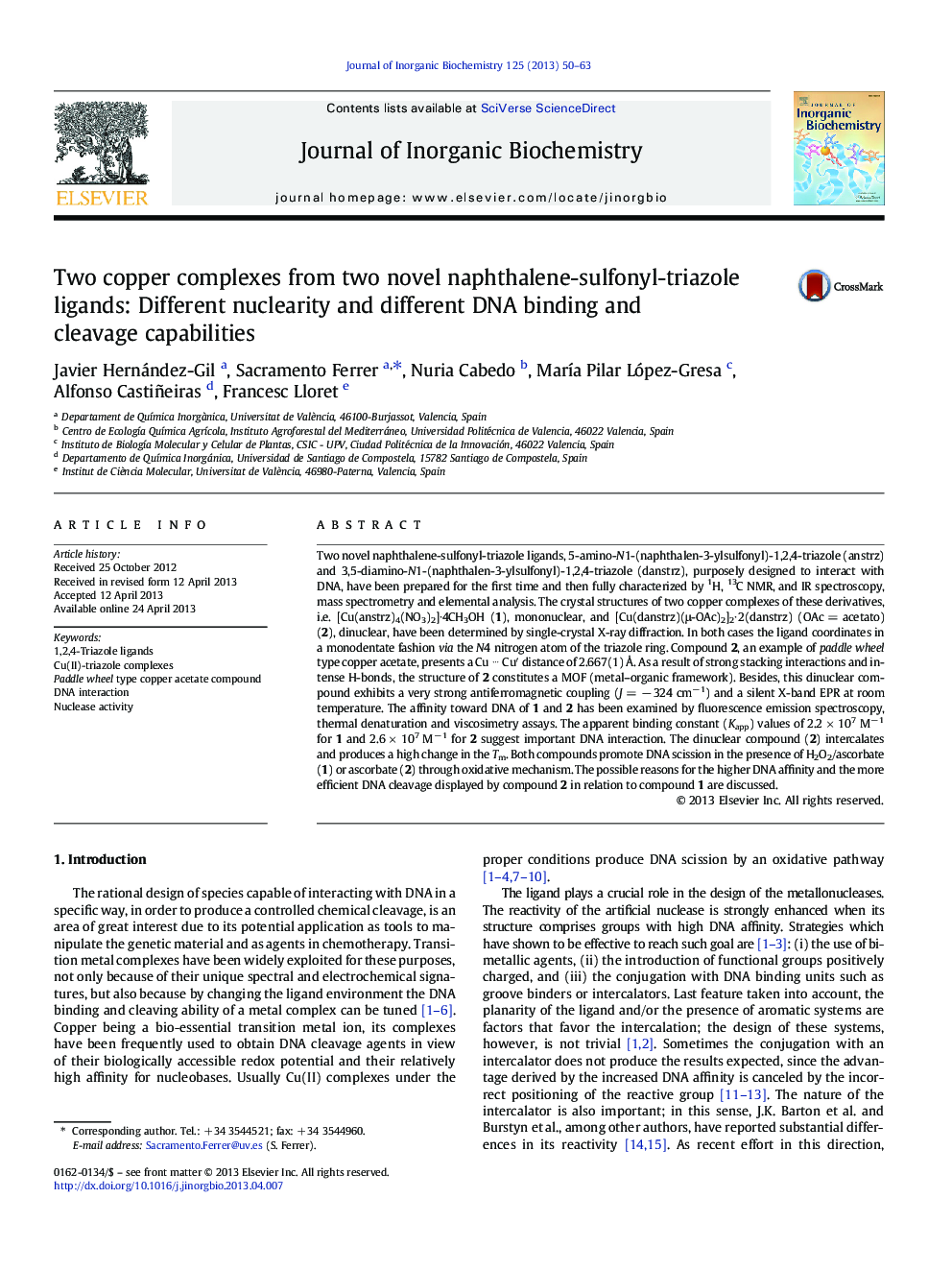| کد مقاله | کد نشریه | سال انتشار | مقاله انگلیسی | نسخه تمام متن |
|---|---|---|---|---|
| 1317596 | 1499462 | 2013 | 14 صفحه PDF | دانلود رایگان |

• Two novel N1-naphthalene-sulfonyl-1,2,4-triazole ligands have been synthesized for the first time.
• Their reaction with Cu(II) salts has afforded one mononuclear and one dinuclear complexes.
• The dinuclear one is a paddle wheel type copper acetate compound with strong antiferromagnetic coupling.
• DNA interaction studies show intercalative binding mode for the dinuclear compound and surface DNA binding for the mononuclear one.
• Efficient oxidative pUC18 DNA cleavage exhibited by the dinuclear complex; limited nuclease activity by the mononuclear one.
Two novel naphthalene-sulfonyl-triazole ligands, 5-amino-N1-(naphthalen-3-ylsulfonyl)-1,2,4-triazole (anstrz) and 3,5-diamino-N1-(naphthalen-3-ylsulfonyl)-1,2,4-triazole (danstrz), purposely designed to interact with DNA, have been prepared for the first time and then fully characterized by 1H, 13C NMR, and IR spectroscopy, mass spectrometry and elemental analysis. The crystal structures of two copper complexes of these derivatives, i.e. [Cu(anstrz)4(NO3)2]∙4CH3OH (1), mononuclear, and [Cu(danstrz)(μ-OAc)2]2∙ 2(danstrz) (OAc = acetato) (2), dinuclear, have been determined by single-crystal X-ray diffraction. In both cases the ligand coordinates in a monodentate fashion via the N4 nitrogen atom of the triazole ring. Compound 2, an example of paddle wheel type copper acetate, presents a Cu ⋯ Cu′ distance of 2.667(1) Å. As a result of strong stacking interactions and intense H-bonds, the structure of 2 constitutes a MOF (metal–organic framework). Besides, this dinuclear compound exhibits a very strong antiferromagnetic coupling (J = − 324 cm− 1) and a silent X-band EPR at room temperature. The affinity toward DNA of 1 and 2 has been examined by fluorescence emission spectroscopy, thermal denaturation and viscosimetry assays. The apparent binding constant (Kapp) values of 2.2 × 107 M− 1 for 1 and 2.6 × 107 M− 1 for 2 suggest important DNA interaction. The dinuclear compound (2) intercalates and produces a high change in the Tm. Both compounds promote DNA scission in the presence of H2O2/ascorbate (1) or ascorbate (2) through oxidative mechanism. The possible reasons for the higher DNA affinity and the more efficient DNA cleavage displayed by compound 2 in relation to compound 1 are discussed.
Two novel N1-naphthalene-sulfonyl-1,2,4-triazole ligands afforded one mononuclear and one dinuclear Cu(II)-complexes. DNA interaction studies indicate intercalative DNA behavior for the dinuclear and surface DNA binding for the mononuclear. The dinuclear exhibits efficient oxidative nuclease activity.Figure optionsDownload as PowerPoint slide
Journal: Journal of Inorganic Biochemistry - Volume 125, August 2013, Pages 50–63